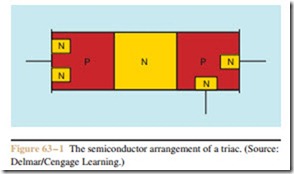The triac is a PNPN junction connected parallel to an NPNP junction. Figure 63– 1 illustrates the semi- conductor arrangement of a triac. The triac operates in a manner similar to that of two connected SCRs (Figure 63– 2). The schematic symbol for the triac is shown in Figure 63– 3.
When an SCR is connected in an AC circuit, the output voltage is direct current. When a triac is connected in an AC circuit, the output voltage is alternating current. Since the triac operates like two SCRs that are connected and facing in opposite directions, it will con- duct both the positive and negative half cycles of AC current.
When a triac is connected in an AC circuit as shown in Figure 63– 4, the gate must be connected to the same polarity as MT2. When the AC voltage applied to MT2 is positive, the SCR, which is forward biased, will con- duct. When the voltage applied to MT2 is negative, the other SCR is forward biased and will conduct that half of the waveform. Since one of the SCRs is forward
biased for each half cycle, the triac will conduct AC current as long as the gate lead is connected to MT2.
The triac, like the SCR, requires a certain amount of gate current to turn it on. Once the triac has been triggered by the gate, it will continue to conduct until the current flowing through MT2 – MT1 drops below the holding current level.
The Triac Used as an AC Switch
The triac is a member of the thyristor family, which means that it has only two states of operation, on and off. When the triac is turned off, it drops the full applied voltage of the circuit at 0 amperes of current flow. When the triac is turned on, it has a voltage drop of about 1 volt, and circuit current must be limited by the load connected to the circuit.
The triac has become very popular in industrial circuits as an AC switch. Since it is a thyristor, it has the ability to control a large amount of voltage and current.
There are no contacts to wear out, it is sealed against dirt and moisture, and it can operate thousands of times per second. The triac is used as the output device of many solid-state relays, which will be covered later. Two types of triacs are shown in Figures 63– 5 and 63– 6.

